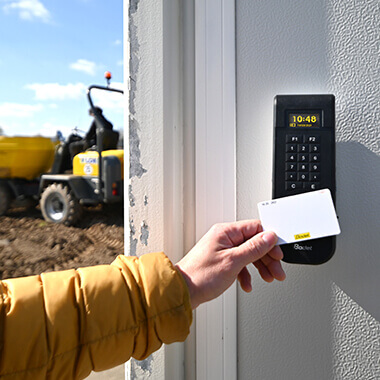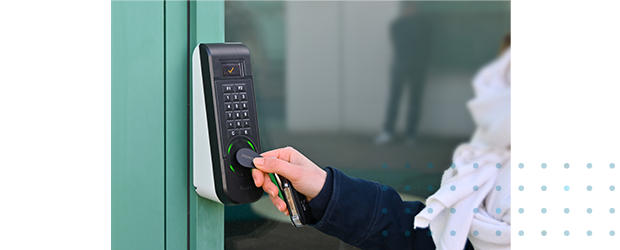
Choose a robust Clocking In System that suits you
Your Clocking In Terminal is an essential tool that your employees use on a daily basis. But is it suitable for your working conditions? Dust, extreme temperatures, water… Your work environment can have a major impact on the efficiency and lifespan of such hardware. How do you choose the most suitable Time & Attendance Terminal for the conditions and installation location? What technical features should you pay attention to when selecting it?
Your Clocking In System and Work Environment: How to combine the two
The environment in which your staff work can limit both the use and installation of electronic equipment.
As with any device containing electronic components, exposure to extreme temperatures, dust, water and even physical impacts can reduce the efficiency and longevity of a Time and Attendance Terminal. It can lead to malfunctions or even equipment failure, preventing staff from clocking in and disrupting HR processes.
This results in wasted time, stress for your employees, and a lot of additional administrative workload.
There are many factors to consider when choosing a suitable Clocking In System if your work environment is not limited to just office space. Let’s examine the characteristics of a Clocking In Terminal according to what it could be exposed to.
Clocking In Machines in the workshop: dust intrusion
Time & Attendance Terminals sometimes need to be installed in dusty environments, such as metallurgical or carpentry workshops.
In this type of environment, various materials are cut, generating very fine particles which your terminal is exposed to. This can affect its operation, so it must be able to resist the infiltration of fine dust and any other unwanted residue.
The IP (Ingress Protection) value of your hardware is the relevant information to pay attention to in this situation. This rating is an international standard relating to the degree of protection provided against intrusion from solid and liquid bodies. It consists of two numbers.
The first number corresponds to the protection against solid bodies, whilst the second indicates the protection against water. That first scale for solid bodies extends from zero to six. In a regular office environment, an IP rating of two is generally sufficient. A Clocking In Terminal with a rating of zero however will allow all kinds of particles to invade the device, ultimately affecting its operation.
Waterproof Clocking In Machines for water resistance
Where it’s necessary to install a Time & Attendance Terminal in an area exposed to moisture, its IP rating is again critical. The most obvious example here is where terminals are mounted outdoors, but there are other situations to consider.
Remember that any kind of humid working conditions, such as in agriculture, can potentially damage a device without a sufficient IP rating. Also, don’t forget to consider how your Clocking In Device is cleaned. If this process involves the user of water jets, again you need to ensure it has the relevant IP rating.
The second digit of the IP index refers to protection against liquid intrusion, with the scale this time ranging from zero to eight. In a typical office environment, an IP value of zero is sufficient. In industrial settings, it’s important to look for Clocking In Systems which have a rating of four or five, which means they are appropriately sealed. Anything higher than five is likely to be excessive, and only relevant in uncommon situations such as the exterior of a boat or lighthouse.
In general, a rating of five is quite sufficient for use either in humid indoor environments, or when exposed to rain outdoors.
Clocking In and temperature variations
Some work environments are exposed to extreme temperatures, be it very hot or very cold. If this is the case for you, your Time & Attendance Terminal must be able to withstand these severe temperatures.
Not all terminals can be installed in a protected environment. Whether in a green house, a refrigerated warehouse, or exterior location exposed to freezing weather or continuous sunlight, your Clocking In Equipment must be suitable for the temperatures it experiences.
All electronic equipment is designed to withstand a certain temperature range. As such, the choice of electronic components and battery must be made in line with those specifications. If exposed to temperatures exceeding the stated range, your Clocking In Device can be irreversibly damaged, or even destroyed; components may cease to function, and the internal battery may swell or even explode in excessively high temperatures. Cold temperatures can also cause the screen to freeze.
Therefore, you must ensure that your Time & Attendance Terminal is resistant to a wide range of temperatures extending from freezing negatives to extreme heat.

Robust Clocking In Systems: protection against shocks
Modern warehouses often have a variety of industrial machinery moving around them. When a Clocking In Terminal is installed in such an environment, it’s essential to ensure it is robust and that the slightest shock will not affect its operation.
With that in mind, it’s wise to look at the international IK code, which measures the strength of impact that a product can withstand. The IK code has a range from 00 to 10. If your Clocking In Terminal is in a location where it’s exposed to possible accidental impacts, it’s critical to check that the impact resistance is sufficient, whilst not opting for hardware with unnecessarily high ratings which will increase the cost.
The IK07 or IK08 ratings offer a good compromise between both protection and price. They offer the following levels of protection:
- IK07 - Protected against 2 joules of impact (the equivalent to the impact of a 0.5kg mass falling from a height of 400mm)
- IK08 - Protected against 5 joules of impact (the equivalent to the impact of a 1.7kg mass falling from a height of 300mm)
Time & Attendance Terminals in bright sunshine or darkness: opt for flawless visibility
When a Clocking In Machine is in an exposed position outdoors, or placed in a dark environment, you must ensure that the screen is always readable. For this reason, it’s important to research what type of screen your prospective hardware uses, as this has a big impact.
The best option is an OLED screen, which does not require a backlight system. It consists of pixels which are each a source of light, creating a very high contrast ratio which provides visibility both in bright light and in the dark. An additional benefit of OLED screens is the wide viewing angle; users don’t need to be exactly in from of the terminal in order to see the screen clearly and register their attendance.

Clocking In Systems in extreme environments: make the right choice!
Understanding the factors mentioned in this article will enable you to select a Clocking In Terminal suitable for extreme working conditions. However, these are not the only factors to consider.
There are other practicalities which affect the daily use of your terminals:
How easy is it to clock in? What kind of clocking in method do you want your staff to use? How easy is it to download your clocking data? These practicalities all affect the daily use of your terminals.
All of these factors need to be given attention in order to find the Clocking In System that will suit both your environment and its users.
Does your workforce operate in conditions such as extreme temperatures, or where dust or other particles are created? Need to capture clocking in data on an external door, or where water jets are used for cleaning? We’ll make sure you have a Clocking In Solution which suits your requirements and working environment.
SPEAK TO OUR EXPERTS NOW SO WE CAN HELP YOU FIND THE CLOCKING IN TERMINAL THAT’S RIGHT FOR YOU
Share the article





























